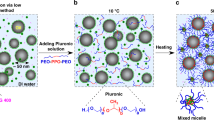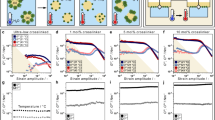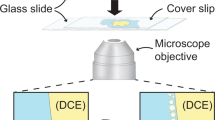Abstract
Emulsions consist of mixtures of immiscible liquids where one liquid is finely dispersed within the continuous phase of another. They are generally not thermodynamically stable: the dispersion tends to separate over time. Aqueous emulsions, widely used in food, pharmaceutical, and many other industries, are often stabilized by block copolymers containing alternating hydrophilic and hydrophobic segments (typically based on ethylene oxide/propylene oxide diblock and triblock systems) that penetrate into the oil and aqueous phase, respectively1,2. Here we describe a conceptually new type of emulsifier whose hydrophobic blocks are formed spontaneously and reversibly by the complexation of hydrophilic segments, thereby allowing the stabilizing properties of the system to be switched on and off. We illustrate this approach using a comb-type graft copolymer containing a poly(methacrylic acid) backbone and short grafts of poly(ethylene glycol). The uncomplexed polymer is hydrophilic, but acidic conditions induce the formation of hydrogen-bonded hydrophobic complexes between parts of the backbone and the grafts. As a result, the grafted copolymer forms alternating blocks of hydrophilic (uncomplexed) and hydrophobic (complexed) segments that stabilize acidic emulsions. An increase in pH suppresses complex formation and thus leads to the breakup of the emulsion. Emulsion tests show that although the performance of the grafted copolymers is not yet competitive with existing emulsifiers, this approach provides an efficient strategy for the design of fully reversible emulsifiers.
This is a preview of subscription content, access via your institution
Access options
Subscribe to this journal
Receive 51 print issues and online access
$199.00 per year
only $3.90 per issue
Buy this article
- Purchase on Springer Link
- Instant access to full article PDF
Prices may be subject to local taxes which are calculated during checkout



Similar content being viewed by others
References
Piirma, I. Polymeric Surfactants(Vol. 2, Surfactant Science Ser., Dekker, New York, (1992)).
Laschewsky, A. Molecular concepts, self-organization and properties of polysoaps. Adv. Polym. Sci. 124, 1–86 (1995).
Tsuchida, E. & Abe, K. Interactions between macromolecules in solution and intermolecular complexes. Adv. Polym. Sci. 45, 1–119 (1982).
Bekturov, E. A. & Bimendina, L. A. Interpolymer complexes. Adv. Polym. Sci. 43, 100–147 (1980).
Osada, Y. Conversion of chemical into mechanical energy by synthetic polymers. Adv. Polym. Sci. 82, 1–46 (1987).
Kabanov, V. A. & Papisov, I. M. Formation of complexes between complementary synthetic polymers and oligomers in dilute solution. Review. Vysokomol. Soyed. A21, 243–281 (1979).
Scranton, A. B., Klier, J. & Aronson, C. L. in Polyelectrolyte Gels(eds Harland, R. S. & Prud'homme, R.K.) 171–189 (ACS Symp. Ser. 480, Am. Chem. Soc., Washington DC, (1992)).
Klier, J., Scranton, A. B. & Peppas, N. A. Self-associating networks of poly(methacrylic acid-g-ethylene glycol). Macromolecules 23, 4944–4949 (1990).
Scranton, A. B., Klier, J. & Peppas, N. A. Complexation thermodynamics of free and graft oligomers with complementary polymers. J. Polym. Sci.: Polym. Phys. 29, 211–224 (1991).
Saito, S. & Sakamoto, T. Solubilization by polymer/polymer complexes. Colloids Surf. 23, 99–104 (1987).
Hemker, D. J., Garza, V. & Frank, C. W. Complexation of poly(acrylic acid) and poly(methacrylic acid) with pyrene-end-labeled poly(ethylene glycol). pH and fluorescence measurements. Macromolecules 23, 4411–4418 (1990).
Noolandi, J. Multiblock copolymers as polymeric surfactants: are “pancakes” better than “dumbbells”? Makromol. Chem. Theory Simul. 1(5), 295–298 (1992).
Mayo, S. L., Olafson, B. D. & Goddard, W. A. DREIDING: A generic force field for molecular simulations. J. Phys. Chem. 94, 8897–8909 (1990).
Author information
Authors and Affiliations
Corresponding author
Rights and permissions
About this article
Cite this article
Mathur, A., Drescher, B., Scranton, A. et al. Polymeric emulsifiers based on reversible formation of hydrophobic units. Nature 392, 367–370 (1998). https://doi.org/10.1038/32856
Received:
Accepted:
Issue Date:
DOI: https://doi.org/10.1038/32856
This article is cited by
-
Application of cesium hydroxide monohydrate for ring opening polymerization of monosubstituted oxiranes: characterization of synthesized polyether-diols
Polymer Bulletin (2021)
-
Characterization of new polyether-diols with different molar masses and modality prepared by ring opening polymerization of oxiranes initiated with anhydrous potassium hydroxide
Journal of Polymer Research (2019)
-
Ring-opening polymerization of monosubstituted oxiranes in the presence of potassium hydride: determination of initiation course and structure of macromolecules by MALDI-TOF mass spectrometry
Journal of Polymer Research (2019)
-
The influence of initiator and macrocyclic ligand on unsaturation and molar mass of poly(propylene oxide)s prepared with various anionic system
Polymer Bulletin (2018)
-
Polyglycerol-poly(ε-caprolactone) block copolymer as a new semi-solid polymeric emulsifier to stabilize O/W nanoemulsions
Colloid and Polymer Science (2015)
Comments
By submitting a comment you agree to abide by our Terms and Community Guidelines. If you find something abusive or that does not comply with our terms or guidelines please flag it as inappropriate.



